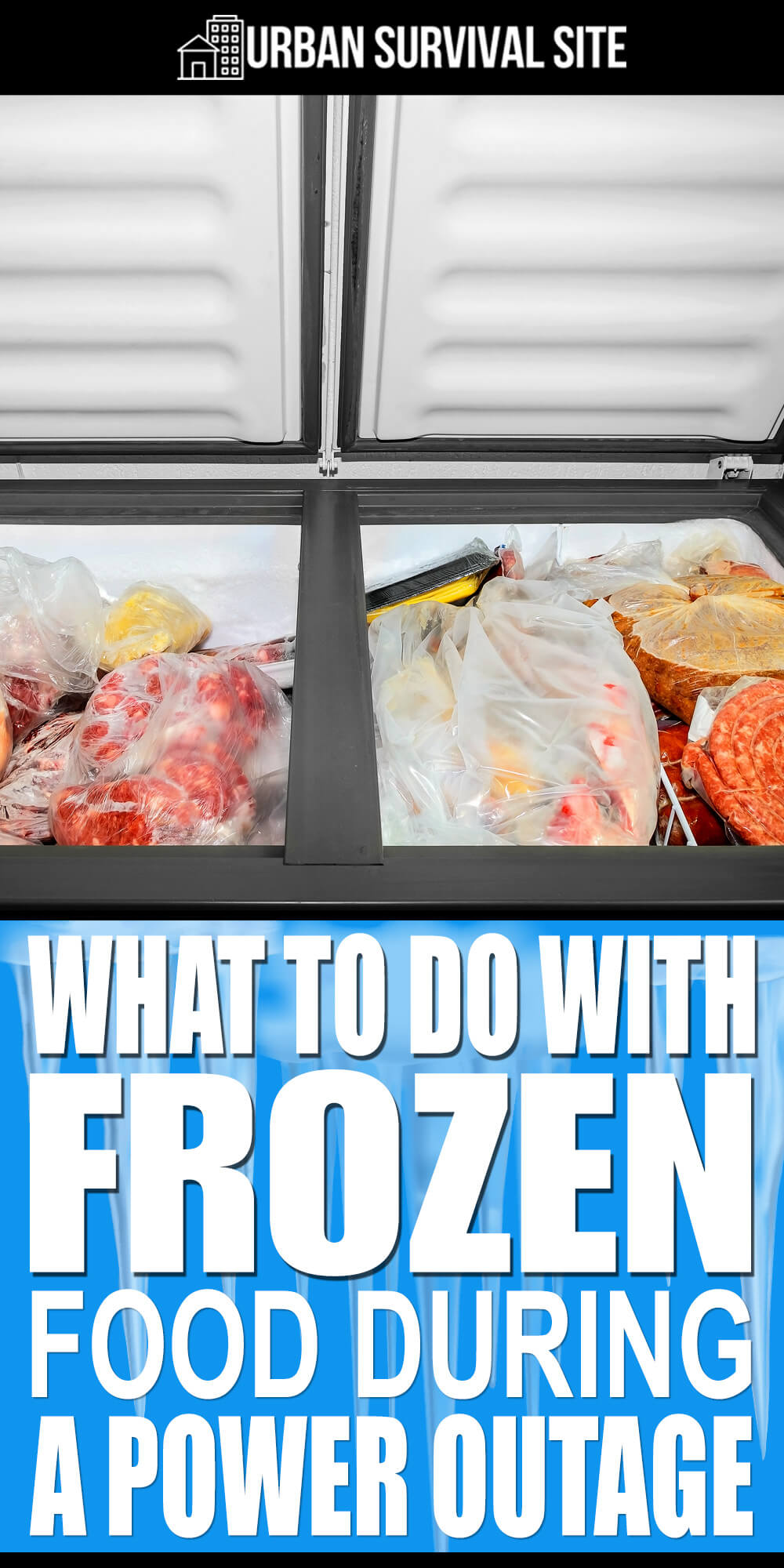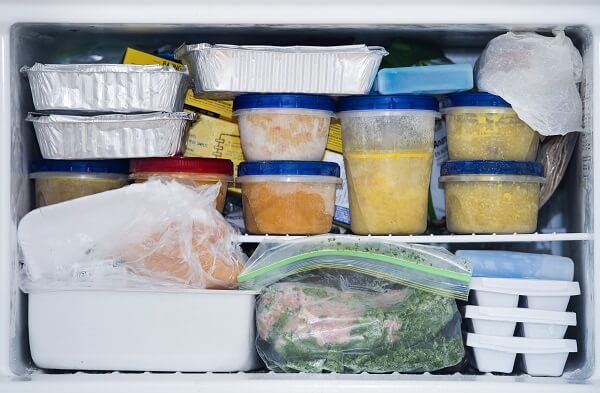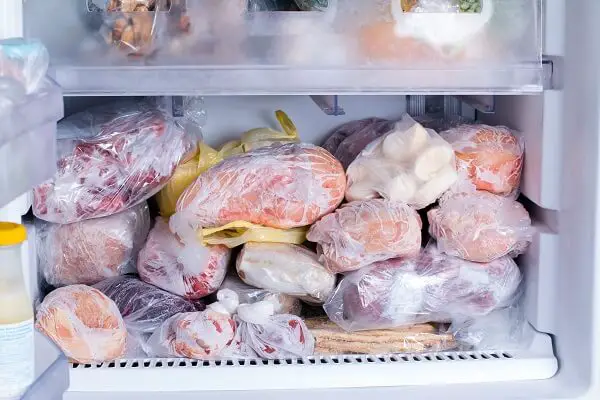The post What to Do With Frozen Food During A Power Outage is republished from http://totalsurvival.net


 It’s happened to all of us at one time or another. The power goes out, and we wonder about the food stored in the freezer. Is it safe to eat? Can you refreeze it?
It’s happened to all of us at one time or another. The power goes out, and we wonder about the food stored in the freezer. Is it safe to eat? Can you refreeze it?
Unfortunately, the answers to these questions are not black and white. You will need to evaluate each item separately. Here are some tips to help you know what to do with frozen food during and after a power outage.
Want to save this post for later? Click Here to Pin It on Pinterest!
1. Keep an appliance thermometer in your freezer. The ideal freezer temperature is 0°F, and a reading of 40 °F or below usually means the food is safe to eat or may be refrozen. Discard perishable food that has been in a freezer above 40 °F for more than two hours.
2. Don’t taste thawed food to determine its freshness or safety. You also cannot rely on appearance or odor to know if it is safe to eat.
3. Don’t open the freezer unless absolutely necessary during a power outage. Save as much coldness as you can until power resumes. An unopened full freezer will maintain its temperature for about 48 hours, and an unopened half-full freezer will hold its temperature for 24 hours. (This is why you should try to always keep your freezer full.)



4. Check for ice crystals on individual items if you don’t have a thermometer. If the food still contains ice crystals, you may refreeze it. Partial thawing may reduce the taste, texture, or quality of this food, but it will be safe to consume.
5. Discard any foods that have come into contact with juices from raw meat. To avoid this problem, place meat and poultry on a tray or in a separate area of the freezer.
6. Use dry ice or block ice to help keep the freezer cold during an outage. Fifty pounds of dry ice can keep a full 18-cubic-feet freezer cold for 48 hours.
7. Throw away items that feel warm to the touch or have an unusual smell, odor, or texture.
8. Follow the rule, “when in doubt, throw it out.” Food poisoning is nothing to fool around with.
9. Group foods close together in the freezer so they stay colder longer in the event of a power outage.
Below is some information from foodsafety.gov to help you know more about specific frozen items.
Meat, Poultry, and Seafood
If the following foods contain ice crystals and feel cold to the touch (as if they have been refrigerated), you may refreeze them:
- Beef
- Casseroles
- Ground Meat
- Ground Poultry
- Lamb
- Stews
- Pork
- Poultry
- Variety Meats (such as liver, kidney, heart, and chitterlings)
- Veal
If items in the previous list have thawed and have been stored above 40°F, then you will need to discard them.
You may refreeze fish, shellfish, and breaded seafood products if they contain ice crystals and feel cold to the touch (as if refrigerated), but they may lose some taste and texture. Once again, if the freezer temperature has exceeded 40 °F for more than two hours, or the items feel warm to the touch, you should throw them away.



Dairy
If the following dairy items contain ice crystals and feel cold to the touch (as if they have been refrigerated), you may refreeze them, but keep in mind that they may lose texture and appearance:
- Eggs (out of shells) and egg products
- Casseroles containing cream, milk, eggs, and soft cheese
- Cheese (all kinds)
- Cheesecake
Discard ice cream and frozen yogurt and discard any of the above items that have been stored for more than two hours in temperatures above 40°F. An exception is hard cheese, which may be refrozen in either case.
Fruits
You can refreeze fruit juice or home or commercially packaged fruits that contain ice crystals or feel as if they came out of the refrigerator. Some fruits will lose flavor and texture when they are frozen. Throw away juices or fruits that have been in a freezer above 40°F for six or more hours.
Vegetables
You may refreeze vegetable juices that are still cold to touch or have ice crystals. Home or commercially packaged veggies that have crystals or seem cold to the touch also may be refrozen. Toss these items if they have been in the freezer for more than six hours at temperatures above 40°F.
Breads
Breads, rolls, muffins, cakes, pies, pie crusts, homemade and commercial bread dough, pastries (without custard fillings) may be refrozen after a power outage of any length. These items may suffer significant quality loss, but they will be safe to eat.
However, if these items have custard or cheese fillings, you should discard them if they have been in a freezer at a temperature of 40°F for more than two hours.
Other Foods
You may refreeze past and rice-based casseroles if they have ice crystals and feel cold. Discard them if they have been in a freezer of more than 40°F for two hours or more. You may refreeze flour, cornmeal, or nuts that have ice crystals and feel cold but discard them if the temperature has been warm for more than two hours.
Frozen breakfast items such as waffles, pancakes, and bagels may be safely refrozen after a power outage, but they may lose texture.
You can refreeze frozen entrees, frozen pizzas, meat pies, and biscuits that have ice crystals and are cold to the touch, but be sure to discard them if the freezer temperature has been over 40°F for two hours or more. Texture loss is likely.
Finally, coolers are ideal for keeping frozen foods cold during a power outage. Store some frozen gel packs in your freezer for use in an emergency. Also, you can use frozen bags of veggies, especially peas, as substitute ice packs to surround your foods and keep them cold.
Like this post? Don’t forget to Pin It on Pinterest!
This article first appeared on urbansurvivalsite.com See it hereRead More Here: What to Do With Frozen Food During A Power Outage

No comments:
Post a Comment